054 #panoptikum #api2art
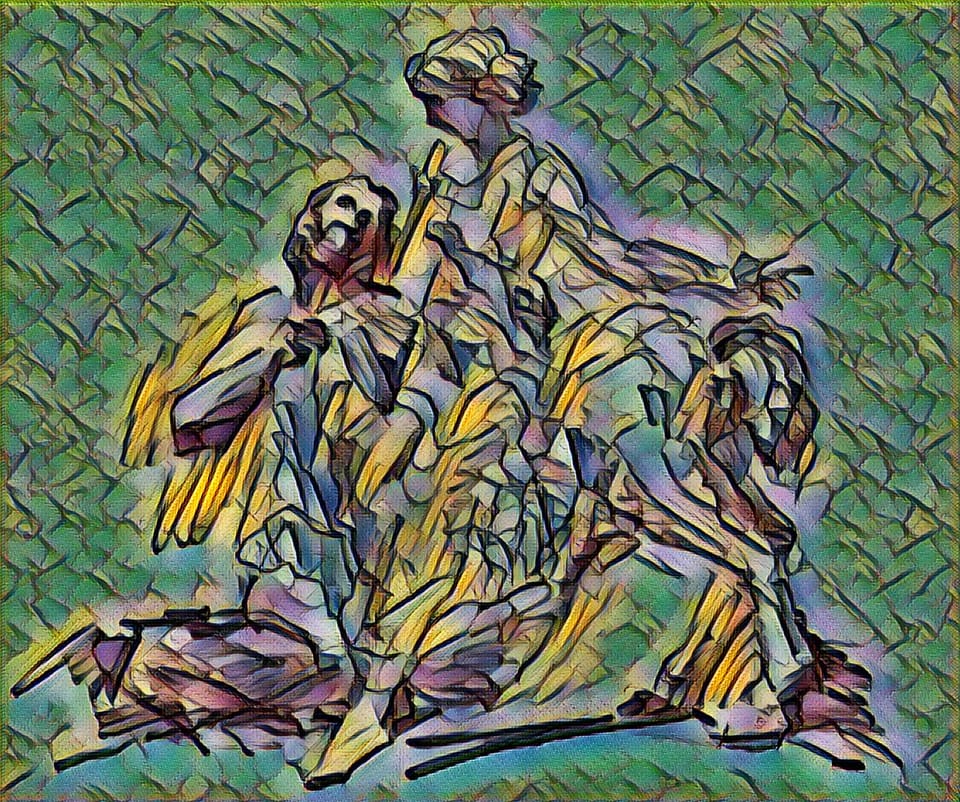
For the past two and a half years, the artist Jürg Straumann has been working on a digital retrospective of his life's work, spanning over four decades of visual art. The latest stage of this project involved creating an interactive way to browse this unique and very personalized database.
A style transfer by Oleg Lavrovsky from Der Raub der Deianira durch den Zentauren Nessus by Jürg Straumann (nach Damià Campeny, 2012) to La muse by Pablo Picasso (1935)
During our workshop on Open Data Day, March 3 - while Rufus Pollock's book The Open Revolution was passed around the room, I introduced a gathering of collectors and art experts to Open Knowledge and OpenGLAM. We discussed the question of how new channels and terms like Creative Commons support both the artwork and the artist in a digital economy. And we got lots of great feedback for our project together, which you can read about in this post.
Wahnsinnig viel Züg, es isch e wahri Freud! (Swiss German, approx. translation: So much stuff, a true delight!)
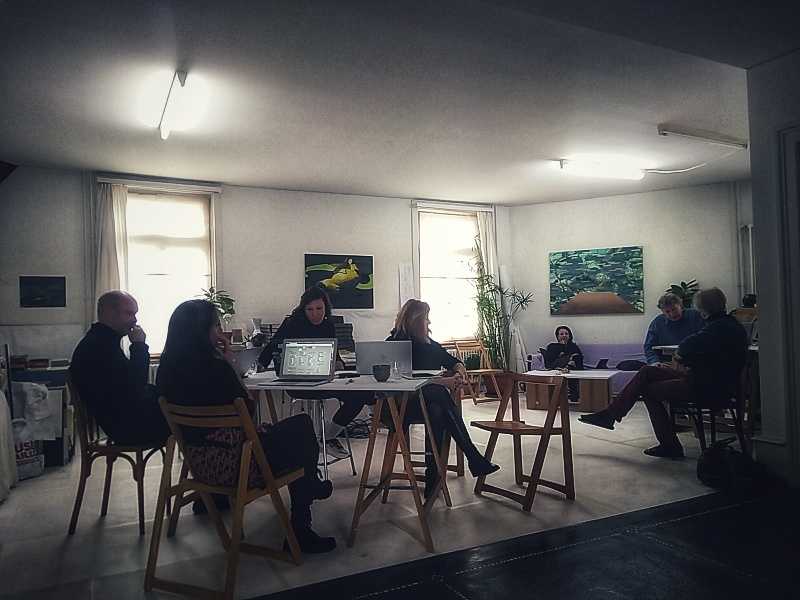
Wenn Kunst vergrabe isch und vergässe gaht, isch es es Problem für alli Aghörige, e furchtbari Belastig für d Nachkomme. (When art is buried and is lost, it is a problem for all involved, a terrible weight for the next generation.)
Skip to Jürg's story, or keep reading for my introduction.
Oleg's story
Over my years as web developer I have worked on several collaborations with artists like Didier Mouron/Don Harper or Roland Zoss/Rene Rios, and on various 'code+art' projects like Portrait Domain with the #GLAMhack and demoscene community. I'm drawn to this kind of project both from a personal interest in art and it's many incarnations, as well as from the fascinating opportunity to get to know the artist and their work.
When Jürg approached me with his request, I quickly recognized that this was a person who was engaged at the intersection of traditional and digital media, who explores the possibilites of networked and remixed art, who is meticulous, scientific, excited by the possibilities and committed to the archiving and preservation of work in the digital commons. I was very impressed with the ongoing efforts to digitize his life works on a large scale, and jumped in to help bring it to an audience.
During this same time, I've been working on implementing the Frictionless Data standards in various projects. Since he gave me complete freedom to propose the solution, the first thing I did was to use Data Package Pipelines to implement a converter for the catalogue, which was in Microsoft Excel format as shown in the screenshot below. In this process we identified various data issues, slightly improved the schema, and created a reliable conversion process which connected the dataset to the image collection. The automatic verifications in this process started helping to accelerate the digitization efforts.
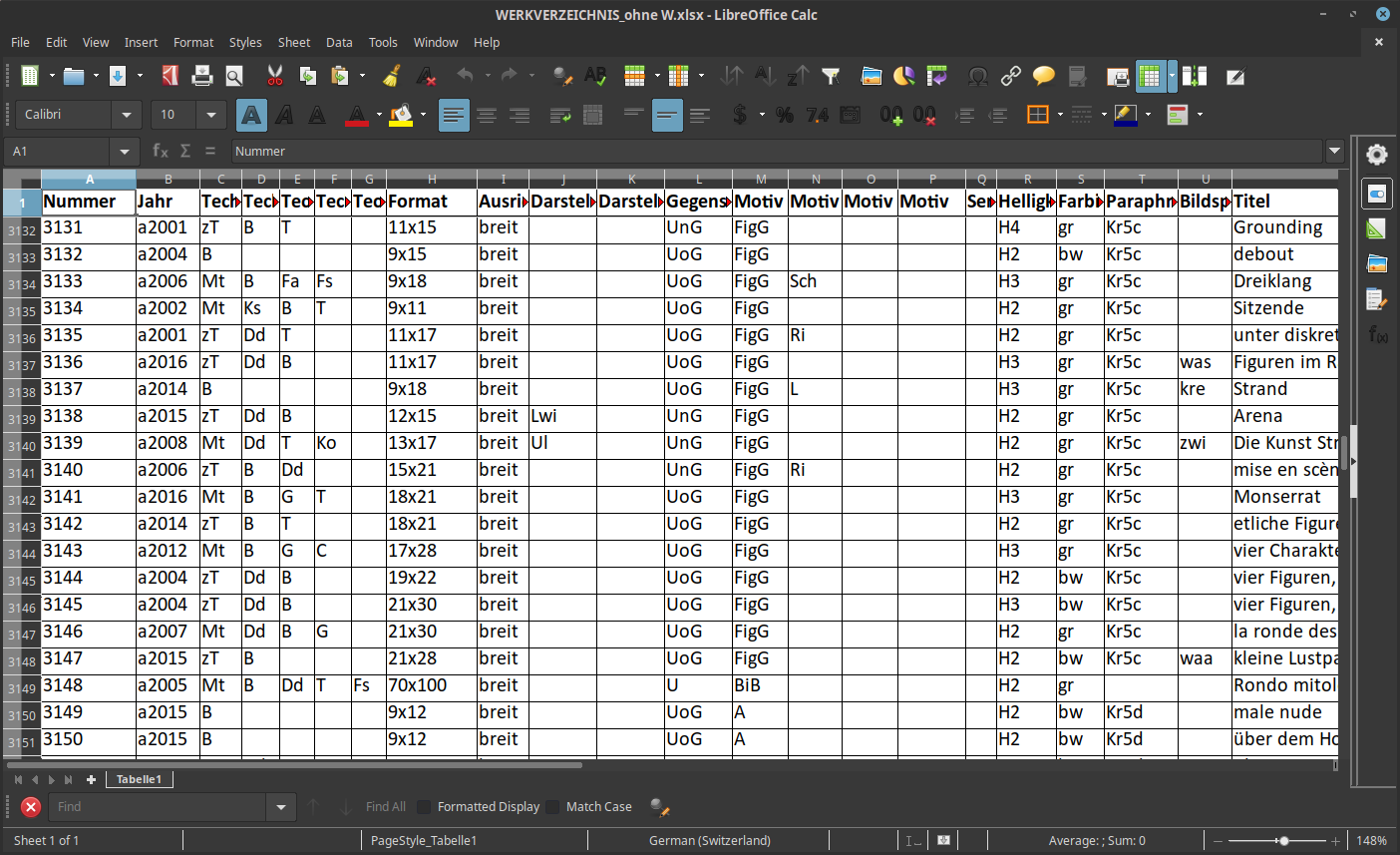
Together with Rebekka Gerber, an art historian who works at the Museum für Gestaltung Zürich, we reviewed various systems used for advanced web galleries and museum websites, such as:
- Europeana - europeana.eu - via glam.opendata.ch
- Omeka S / Classic - showcase - via openglam.org
- Collective Access - showcase
- TMS Suite - emuseum.ch
- Wagtail / Django - RCA Now / Museum Arnhem
While they all had their advantages and disadvantages, we remained unsure which one to commit to: budget and time constraints led us to take the "lowest hanging fruit", and ...not use any backend at all. Our solution, inspired by the csvapi project by Open Data Team, is an instant JSON API. Like their csvapi, ours works directly from the CSV files, which are first referenced from the Data Package generated by our pipeline using the Python Data Package library. Based on this API, I wrote a simple frontend using the Twitter Bootstrap framework I'm used to hacking on for short term projects.
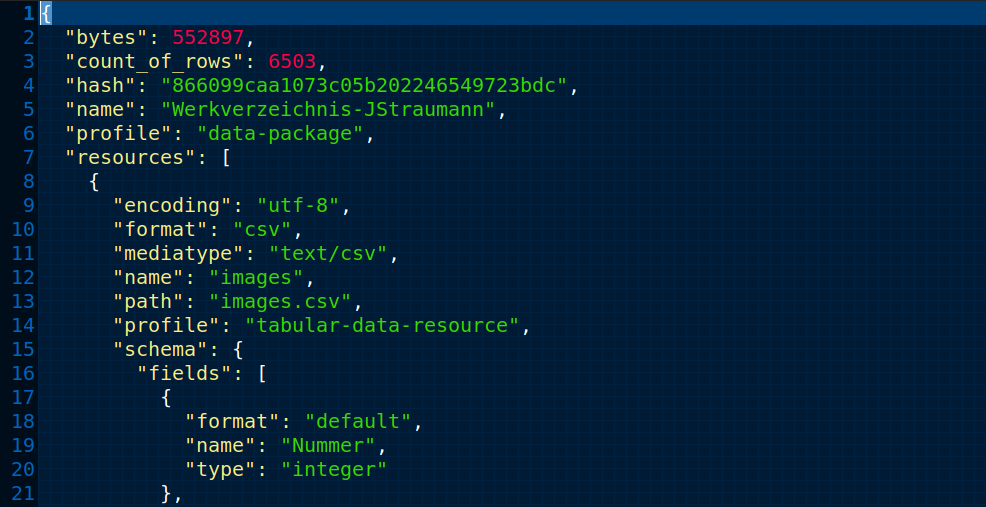
Et voilà! A powerful search interface in the hands of one of our first beta-testers. When you see it - and I hope pretty soon at least a partial collection will be available online - you'll notice a ton of options. Three screen-fulls of various filters and settings to delight the art collector, exploring the collection of nearly 7'000 images with carefully nuanced features.
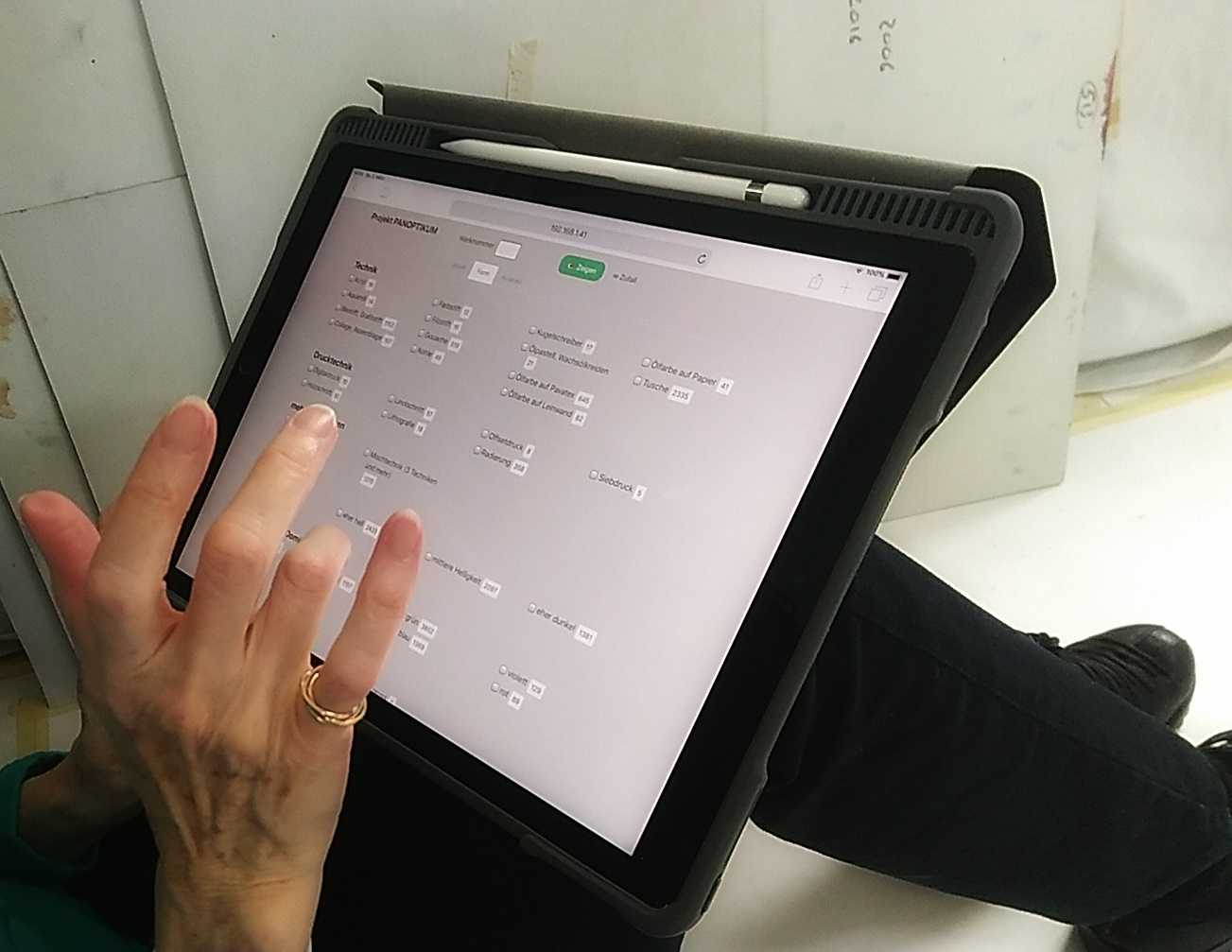
If you've been reading this blog, you can imagine that it is a collection that could also delight a Data Scientist. If there is interest, I am happy to separately open source the API generator that was made in this project. And our goal is to get this API out there in the hands of fellow artists and remixers. For now, you can check out the code in app.py.
The open source project is available at github.com/loleg/panoptikum, and we are going to continue working on future developments in this repository. The content is not yet available to the public, since we are still working out the copyright conditions and practical questions. Nevertheless, we wish to share some insight into this project with more people through workshops, exhibitions and this blog.
More on all that in future posts. In the meantime, I'll let Jürg share more background on the project in his own words. Subscribe to our GitHub repository to be notified of progress - and stay tuned!
Story
(This is the story of the project written by Jürg and translated with DeepL's help. Unten kannst du der Original auf Deutsch lesen.)
In a good 40 years of work as a visual artist (in the conventional media of drawing, printmaking and painting), over 6,600 smaller and larger works have accumulated in my collection. In retrospect, these prove to be unusually diverse, but with sporadically recurring elements, somehow connected by a personal "sound". Very early on I tried to systematize the spontaneous development of sculpture in different directions. This is the basic idea of the project PANOPTIKUM (since 2000), whereby the categorizations of the whole uncontrolled growth are only the basis for further artistic works - which should, ironically, dissolve the whole again.
In the middle of 2016, with the help of numerous experts, I began to compile a catalogue of my works, i.e. to scan or photograph my works and then to index them in a differentiated way in an Excel spreadsheet. In 2018, Oleg Lavrovsky agreed to make the collected data accessible as desired, i.e. after entering the search terms, to display the respective images numerically and optically on the screen by means of a filter function. This is a prerequisite for the fact that in the coming years it will be possible to continue working with the image material in a variety of creative ways. Our project takes the form of an application, which can also be reviewed and further developed by other people (Open Source). The copyright and publication rights for all content remain with me, the created app can be freely used as a structure for other projects. In the longer term, general accessibility via the Internet is planned. At the moment, however, all content should only be available to individual interested parties.
After the completion of this basic work, whereby the directory is to be supplemented about every six months, the task now is to concretize own artistic projects: digital graphics and an interactive work as well as possibly videos are pending. For this I am dependent on expert support, the search for interested persons continues. Commissioned works as well as forms of egalitarian cooperation are possible. In addition, the image material may also be made available for independent projects of third parties.
The starting point and pivotal point of the PANOPTIKUM project is in any case the question of what can be done with a catalogued visual work. A wide variety of sub-projects can be created over an unlimited period of time (artistically, art historically, statistically, literarily, musically, didactically, psychologically, parodistically... depending on the point of view and interests of the participants).
The central idea is to make a visual work accessible in an unusual and entertaining way. To capture additional public benefit through revision. Potential goals include:
- Unusual: the very differentiated formal and content-related recording of one's own work, which becomes the basis for further creations (self-reflexiveness and reference to the outside world).
- Entertaining: exploring in a playful way (e.g. searching for the unknown author of this picture pool, memory, domino, competition, etc.) by means of interactive functions, games, VR applications.
- Artistic work: my own works (approx. 6,600 drawings, paintings and prints), which are presented anonymously and with a good pinch of irony and questioned.
- Making accessible: multimedia, on various channels: exhibition spaces (also improvised and private), internet, cinema. The target audience is as broad as possible, especially outside the usual art scene.
- Stimulating: the desire to look, the pleasure of pleasurable immersion (flood of images!). On the other hand, thoughts about identity, freedom, openness.
- Useful: sustainability material: ecological aspects in production and presentation. Social sustainability: smaller events, e.g. with the sale of the works at very favourable conditions in favour of "Public Eye" (instead of a rubble dump at the end of life!). Thus discussion about artist's estates, archiving, economic aspects (art trade). Any visual material for teaching (art history, art mediation)?
Next steps: Work on the overall concept, on a "story" with scriptwriters, event managers, advertisers, etc. One idea we call the Kunstfund would ask: who is the author? Take the role of art historians, amateurs, gallery owners, art critics and collectors, and speculate; picture disputes, questions of taste; search for meaning; models for political systems - all slightly spunky and ironic.
Parallel to this, experimenting with concrete formal implementations:
- How can my very sensually influenced, conventionally designed images be staged and brought into a visually attractive contrast with the digitally generated elements. For example, by means of split screens, transparencies, animated lettering, infographics, combinations with photo and video material from the "outside world", whereby my collage books could serve as a bridge.
- Function which continuously (anonymously if desired) records all activities and creations of the users - for example, in the design of virtual exhibition spaces with my pictures.
Visit Jürg's website for glimpses into his work and contact options.
Geschichte
Text von Jürg Straumann
Nach gut 40 Jahren Arbeit als bildender Künstler (in den konventionellen Medien Zeichnung, Druckgrafik und Malerei) haben sich über 6‘600 kleinere und grössere Arbeiten angehäuft. Diese erweisen sich im Rückblick als ungewöhnlich vielfältig, aber mit sporadisch wiederkehrenden Elementen, und irgendwie miteinander verbunden durch einen persönlichen „Klang“. Schon ganz früh habe ich die sich spontan in unterschiedliche Richtungen entwickelnde Bildnerei zu systematisieren versucht. Dies bildet denn auch die Grundidee zum Projekt PANOPTIKUM (ab 2000), wobei die Kategorisierungen des ganzen Wildwuchses bloss die Basis für weitere künstlerische Arbeiten sind, welche das Ganze wieder ironisch auflösen sollen.
Mitte 2016 habe ich damit begonnen, mit Hilfe zahlreicher Fachpersonen ein Werkverzeichnis zu erstellen, d.h. meine Arbeiten zu scannen oder zu fotografieren und danach in einer Excel-Tabelle differenziert zu verschlagworten. 2018 hat sich Oleg Lavrovsky bereit erklärt, die gesammelten Daten wunschgemäss zugänglich zu machen, d.h. nach Eingabe der Suchbegriffe die jeweiligen Bilder mittels Filterfunktion auf dem Bildschirm zahlenmässig und optisch darzustellen. Dies als Voraussetzung dafür, dass in den nächsten Jahren gestalterisch auf vielfältige Weise mit dem Bildmaterial weitergearbeitet werden kann. Der Auftrag beinhaltet die Erstellung und Lieferung einer App, welche auch von andern Personen gehandhabt und weiterentwickelt werden kann (Open Source). Die Urheber- und Veröffentlichungsrechte aller Inhalte bleiben bei mir, die erstellte App als Struktur kann von anderen frei weiterverwendet werden. Längerfristig ist eine allgemeine Zugänglichkeit über das Internet vorgesehen. Im Moment sollen aber noch alle Inhalte nur für einzelne Interessierte verfügbar sein.
Nach der Fertigstellung dieser Grundlagenarbeit (wobei das Verzeichnis etwa halbjährlich ergänzt werden soll) geht es nun darum, eigene künstlerische Projekte zu konkretisieren, wobei Digitalgrafik und eine interaktive Arbeit sowie evt. Videos anstehen. Dazu bin ich auf sachkundige Unterstützung angewiesen. Die Suche nach interessierten Personen geht also weiter. Dabei sind Auftragsarbeiten ebenso wie Formen egalitärer Zusammenarbeit möglich. Darüber hinaus kann das Bildmaterial evt. auch für unabhängige Projekte dritter Personen zur Verfügung gestellt werden.
Ausgangs- und Angelpunkt des Projekts PANOPTIKUM ist jedenfalls die Frage, was sich mit einem katalogisierten bildnerischen Werk anstellen lässt. Dabei können über eine unbegrenzte Zeit unterschiedlichste Teilprojekte entstehen (je nach Blickwinkel und Interessen der Beteiligten künstlerisch, kunsthistorisch, statistisch, literarisch, musikalisch, didaktisch, psychologisch, parodistisch...).
Die Leitidee: Auf ungewohnte und unterhaltsame Weise ein bildnerisches Werk zugänglich machen. Durch Aktualisierung einen öffentlichen Nutzen erzielen.
- ungewohnt: die sehr differenzierte formale und inhaltliche Erfassung eines eigenen Werks, welche Grundlage für weitere Kreationen wird (Selbstreflexivität und Bezug zum Aussen).
- unterhaltsam: Erkunden auf spielerische Weise (z.B. Suche nach dem/der unbekannten AutorIn dieses Bildfundus, Memory, Domino, Wettbewerb usw.) mittels interaktiver Funktionen, Games, VR-Anwendungen.
- bildnerisches Werk: meine eigenen Arbeiten (ca. 6‘600 Zeichnungen, Malereien und Druckgrafiken), die anonym und mit einer guten Prise Ironie präsentiert und hinterfragt werden.
- zugänglich machen: multimedial, auf verschiedensten Kanälen: Ausstellungsräume (auch improvisierte und private), Internet, Kino. Das Zielpublikum ist möglichst breit, speziell auch ausserhalb des üblichen Kunstbetriebs.
- anregend: Schaulust, Freude am genüsslichen Eintauchen (Bilderflut!). Anderseits Gedanken über Identität, Freiheit, Offenheit.
- nützlich: Nachhaltigkeit materiell: ökologische Aspekte bei der Produktion und Präsentation. Nachhaltigkeit sozial: kleinere Events z.B. mit Veräusserung der Werke zu sehr günstigen Bedingungen zugunsten von „Public Eye“ (statt Schuttmulde am Lebensende!). Dadurch Diskussion über Künstlernachlässe, Archivierung, ökonomische Aspekte (Kunsthandel). Evt. Anschauungsmaterial für Unterricht (Kunstgeschichte, Kunstvermittlung)?
Nächste Schritte: Arbeiten am Gesamtkonzept, an einer „Story“ mit DrehbuchautorInnen, EventmanagerInnen, WerberInnen usw. (z.B. Kunstfund: wer ist der Autor? Kunsthistoriker, Laien, Galeristen, Kunstkritiker und -sammler usw. spekulieren; Bilderstreit, Geschmacksfragen; Sinnsuche; Modelle für politische Systeme – alles leicht versponnen und ironisierend).
Parallel dazu Experimentieren mit konkreten formalen Umsetzungen:
- Wie sind meine sehr sinnlich geprägten, konventionell gestalteten Bilder zu inszenieren und in einen visuell attraktiven Kontrast mit den digital generierten Elementen zu bringen (z.B. mittels Split Screens, Transparenzen, animierten Schriftzügen, Infografiken, Kombinationen mit Foto- und Videomaterial aus der „Aussenwelt“, wobei meine Collagebücher als Brücke dienen könnten)?
- Funktion, welche fortlaufend (auf Wunsch anonymisiert) alle Aktivitäten und Kreationen der BenutzerInnen (z.B. Gestaltung virtueller Ausstellungsräume mit meinen Bildern) aufzeichnet.
Visit Jürg's website for glimpses into his work and contact options.

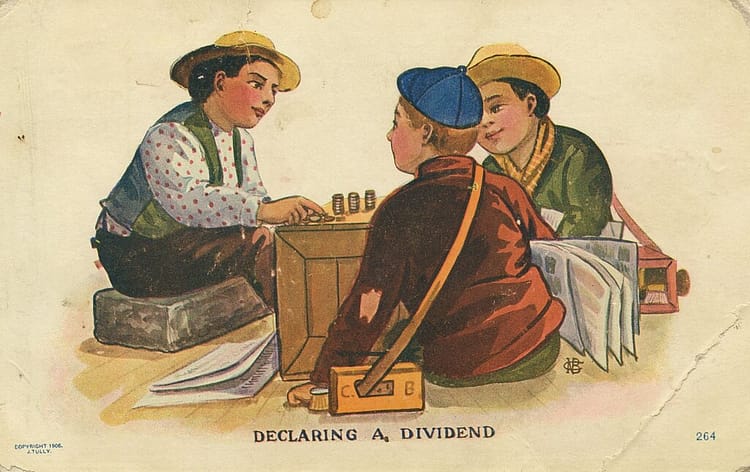

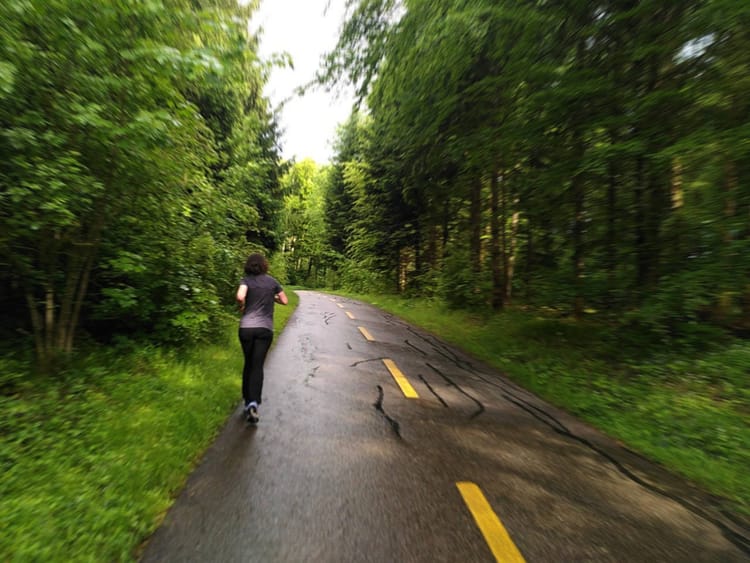

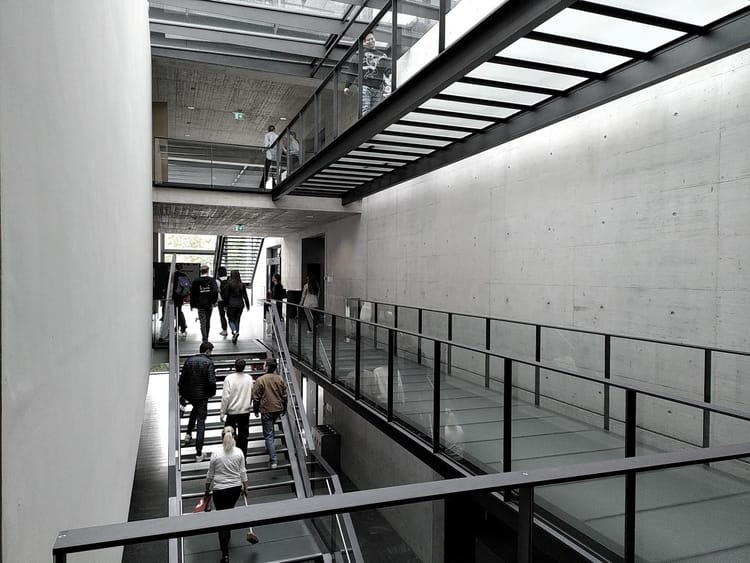
 The works on this blog are licensed under a Creative Commons Attribution 4.0 International License
The works on this blog are licensed under a Creative Commons Attribution 4.0 International License